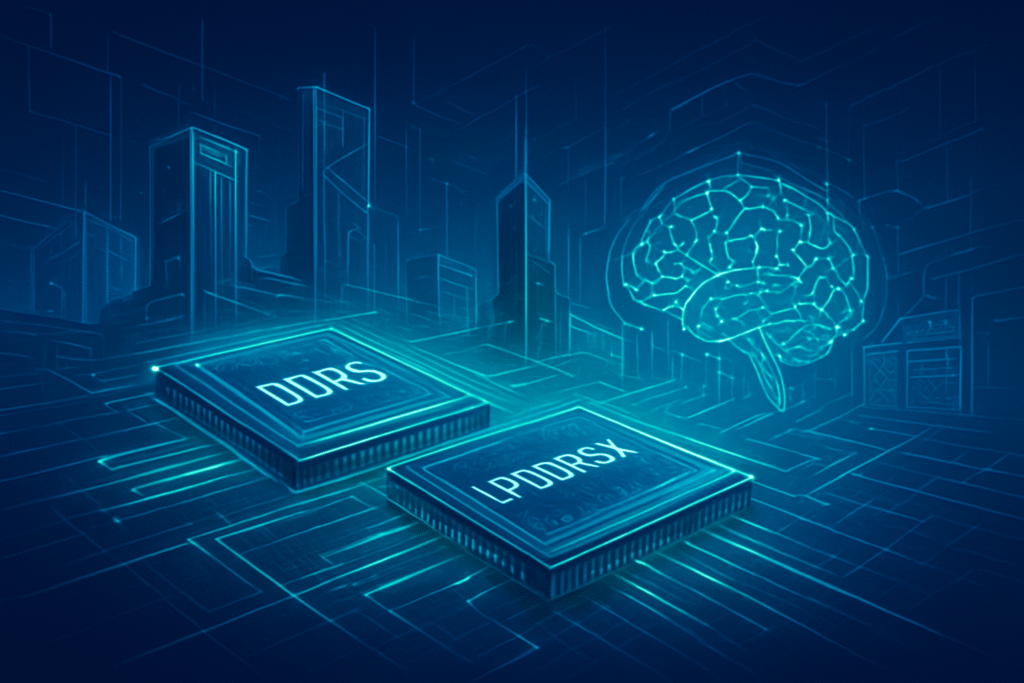
In a monumental stride for China's semiconductor industry, ChangXin Memory Technologies (CXMT) has officially announced its aggressive entry into the high-speed DDR5 and LPDDR5X memory markets. The company made a significant public debut at the 'IC (Integrated Circuit) China 2025' exhibition in Beijing on November 23-24, 2025, unveiling its cutting-edge memory products. This move is not merely a product launch; it signifies China's burgeoning ambition in advanced semiconductor manufacturing and poses a direct challenge to established global memory giants, potentially reshaping the competitive landscape and offering new dynamics to the global supply chain, especially amidst the ongoing AI-driven demand surge.
CXMT's foray into these advanced memory technologies introduces a new generation of high-speed modules designed to meet the escalating demands of modern computing, from data centers and high-performance desktops to mobile devices and AI applications. This development, coming at a time when the world grapples with semiconductor shortages and geopolitical tensions, underscores China's strategic push for technological self-sufficiency and its intent to become a formidable player in the global memory market.
Technical Prowess: CXMT's New High-Speed Memory Modules
CXMT's new offerings in both DDR5 and LPDDR5X memory showcase impressive technical specifications, positioning them as competitive alternatives to products from industry leaders.
For DDR5 memory modules, CXMT has achieved speeds of up to 8,000 Mbps (or MT/s), representing a significant 25% improvement over their previous generation products. These modules are available in 16 Gb and 24 Gb die capacities, catering to a wide array of applications. The company has announced a full spectrum of DDR5 products, including UDIMM, SODIMM, RDIMM, CSODIMM, CUDIMM, and TFF MRDIMM, targeting diverse market segments such as data centers, mainstream desktops, laptops, and high-end workstations. Utilizing a 16 nm process technology, CXMT's G4 DRAM cells are reportedly 20% smaller than their G3 predecessors, demonstrating a clear progression in process node advancements.
In the LPDDR5X memory lineup, CXMT is pushing the boundaries with support for speeds ranging from 8,533 Mbps to an impressive 10,667 Mbps. Die options include 12Gb and 16Gb capacities, with chip-level solutions covering 12GB, 16GB, and 24GB. LPCAMM modules are also offered in 16GB and 32GB variants. Notably, CXMT's LPDDR5X boasts full backward compatibility with LPDDR5, offers up to a 30% reduction in power consumption, and a substantial 66% improvement in speed compared to LPDDR5. The adoption of uPoP® packaging further enables slimmer designs and enhanced performance, making these modules ideal for mobile devices like smartphones, wearables, and laptops, as well as embedded platforms and emerging AI markets.
The industry's initial reactions are a mix of recognition and caution. Observers generally acknowledge CXMT's significant technological catch-up, evaluating their new products as having performance comparable to the latest DRAM offerings from major South Korean manufacturers like Samsung Electronics (KRX: 005930) and SK Hynix (KRX: 000660), and U.S.-based Micron Technology (NASDAQ: MU). However, some industry officials maintain a cautious stance, suggesting that while the specifications are impressive, the actual technological capabilities, particularly yield rates and sustained mass production, still require real-world validation beyond exhibition samples.
Reshaping the AI and Tech Landscape
CXMT's aggressive entry into the high-speed memory market carries profound implications for AI companies, tech giants, and startups globally.
Chinese tech companies stand to benefit immensely, gaining access to domestically produced, high-performance memory crucial for their AI development and deployment. This could reduce their reliance on foreign suppliers, offering greater supply chain security and potentially more competitive pricing in the long run. For global customers, CXMT's emergence presents a "new option," fostering diversification in a market historically dominated by a few key players.
The competitive implications for major AI labs and tech companies are significant. CXMT's full-scale market entry could intensify competition, potentially tempering the "semiconductor super boom" and influencing pricing strategies of incumbents. Samsung, SK Hynix, and Micron Technology, in particular, will face increased pressure in key markets, especially within China. This could lead to a re-evaluation of market positioning and strategic advantages as companies vie for market share in the rapidly expanding AI memory segment.
Potential disruptions to existing products or services are also on the horizon. With a new, domestically-backed player offering competitive specifications, there's a possibility of shifts in procurement patterns and design choices, particularly for products targeting the Chinese market. CXMT is strategically leveraging the current AI-driven DRAM shortage and rising prices to position itself as a viable alternative, further underscored by its preparation for an IPO in Shanghai, which is expected to attract strong domestic investor interest.
Wider Significance and Geopolitical Undercurrents
CXMT's advancements fit squarely into the broader AI landscape and global technology trends, highlighting the critical role of high-speed memory in powering the next generation of artificial intelligence.
High-bandwidth, low-latency memory like DDR5 and LPDDR5X are indispensable for AI applications, from accelerating large language models in data centers to enabling sophisticated AI processing at the edge in mobile devices and autonomous systems. CXMT's capabilities will directly contribute to the computational backbone required for more powerful and efficient AI, driving innovation across various sectors.
Beyond technical specifications, this development carries significant geopolitical weight. It marks a substantial step towards China's goal of semiconductor self-sufficiency, a strategic imperative in the face of ongoing trade tensions and technology restrictions imposed by countries like the United States. While boosting national technological resilience, it also intensifies the global tech rivalry, raising questions about fair competition, intellectual property, and supply chain security. The entry of a major Chinese player could influence global technology standards and potentially lead to a more fragmented, yet diversified, memory market.
Comparisons to previous AI milestones underscore the foundational nature of this development. Just as advancements in GPU technology or specialized AI accelerators have enabled new AI paradigms, breakthroughs in memory technology are equally crucial. CXMT's progress is a testament to the sustained, massive investment China has poured into its domestic semiconductor industry, aiming to replicate past successes seen in other national tech champions.
The Road Ahead: Future Developments and Challenges
The unveiling of CXMT's DDR5 and LPDDR5X modules sets the stage for several expected near-term and long-term developments in the memory market.
In the near term, CXMT is expected to aggressively expand its market presence, with customer trials for its highest-speed 10,667 Mbps LPDDR5X variants already underway. The company's impending IPO in Shanghai will likely provide significant capital for further research, development, and capacity expansion. We can anticipate more detailed announcements regarding partnerships and customer adoption in the coming months.
Longer-term, CXMT will likely pursue further advancements in process node technology, aiming for even higher speeds and greater power efficiency to remain competitive. The potential applications and use cases are vast, extending into next-generation data centers, advanced mobile computing, automotive AI, and emerging IoT devices that demand robust memory solutions.
However, significant challenges remain. CXMT must prove its ability to achieve high yield rates and consistent quality in mass production, overcoming the skepticism expressed by some industry experts. Navigating the complex geopolitical landscape and potential trade barriers will also be crucial for its global market penetration. Experts predict a continued narrowing of the technology gap between Chinese and international memory manufacturers, leading to increased competition and potentially more dynamic pricing in the global memory market.
A New Era for Global Memory
CXMT's official entry into the high-speed DDR5 and LPDDR5X memory market represents a pivotal moment in the global semiconductor industry. The key takeaways are clear: China has made a significant technological leap, challenging the long-standing dominance of established memory giants and strategically positioning itself to capitalize on the insatiable demand for high-performance memory driven by AI.
This development holds immense significance in AI history, as robust and efficient memory is the bedrock upon which advanced AI models are built and executed. It contributes to a more diversified global supply chain, which, while potentially introducing new competitive pressures, also offers greater resilience and choice for consumers and businesses worldwide. The long-term impact could reshape the global memory market, accelerate China's technological ambitions, and potentially lead to a more balanced and competitive landscape.
As we move into the coming weeks and months, the industry will be closely watching CXMT's production ramp-up, the actual market adoption of its new modules, and the strategic responses from incumbent memory manufacturers. This is not just about memory chips; it's about national technological prowess, global competition, and the future infrastructure of artificial intelligence.
This content is intended for informational purposes only and represents analysis of current AI developments.
TokenRing AI delivers enterprise-grade solutions for multi-agent AI workflow orchestration, AI-powered development tools, and seamless remote collaboration platforms.
For more information, visit https://www.tokenring.ai/.






